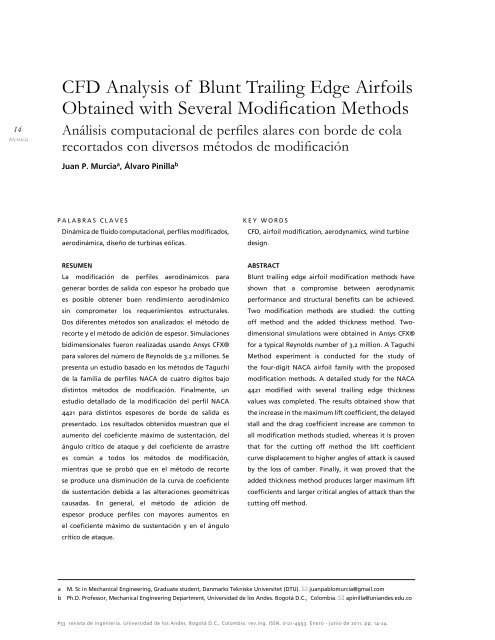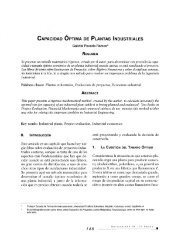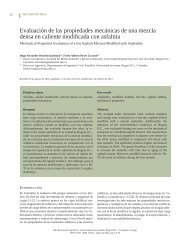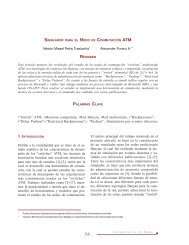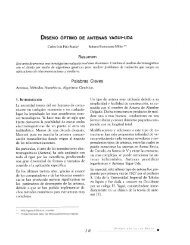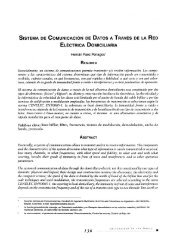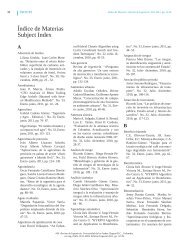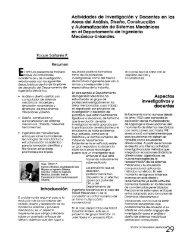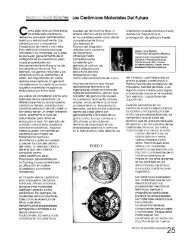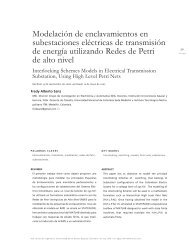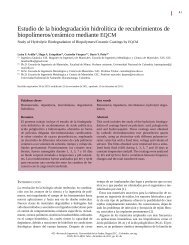CFD Analysis of Blunt Trailing Edge Airfoils Obtained with Several ...
CFD Analysis of Blunt Trailing Edge Airfoils Obtained with Several ...
CFD Analysis of Blunt Trailing Edge Airfoils Obtained with Several ...
You also want an ePaper? Increase the reach of your titles
YUMPU automatically turns print PDFs into web optimized ePapers that Google loves.
14<br />
técnica<br />
<strong>CFD</strong> <strong>Analysis</strong> <strong>of</strong> <strong>Blunt</strong> <strong>Trailing</strong> <strong>Edge</strong> <strong>Airfoils</strong><br />
<br />
<br />
<br />
Juan P. Murcia a , Álvaro Pinilla b<br />
PALABRAS CLAVES<br />
<br />
aerodinámica, diseño de turbinas eólicas.<br />
KEY WORDS<br />
<br />
design.<br />
RESUMEN<br />
<br />
generar bordes de salida con espesor ha probado que<br />
es posible obtener buen rendimiento aerodinámico<br />
sin comprometer los requerimientos estructurales.<br />
Dos diferentes métodos son analizados: el método de<br />
recorte y el método de adición de espesor. Simulaciones<br />
bidimensionales fueron realizadas usando Ansys CFX®<br />
para valores del número de Reynolds de 3.2 millones. Se<br />
presenta un estudio basado en los métodos de Taguchi<br />
<br />
<br />
<br />
4421 para distintos espesores de borde de salida es<br />
presentado. Los resultados obtenidos muestran que el<br />
<br />
<br />
<br />
mientras que se probó que en el método de recorte<br />
<br />
de sustentación debida a las alteraciones geométricas<br />
causadas. En general, el método de adición de<br />
<br />
<br />
crítico de ataque.<br />
ABSTRACT<br />
<br />
shown that a compromise between aerodynamic<br />
<br />
<br />
<strong>of</strong>f method and the added thickness method. Twodimensional<br />
simulations were obtained in Ansys CFX®<br />
for a typical Reynolds number <strong>of</strong> 3.2 million. A Taguchi<br />
Method experiment is conducted for the study <strong>of</strong><br />
the four-digit NACA airfoil family <strong>with</strong> the proposed<br />
<br />
<br />
values was completed. The results obtained show that<br />
<br />
<br />
<br />
<br />
curve displacement to higher angles <strong>of</strong> attack is caused<br />
by the loss <strong>of</strong> camber. Finally, it was proved that the<br />
added thickness method produces larger maximum lift<br />
<br />
cutting <strong>of</strong>f method.<br />
a<br />
b<br />
M. Sc in Mechanical Engineering, Graduate student, Danmarks Tekniske Universitet (DTU). juanpablomurcia@gmail.com<br />
Ph.D. Pr<strong>of</strong>essor, Mechanical Engineering Department, Universidad de los Andes. Bogotá D.C., Colombia. apinilla@uniandes.edu.co<br />
#33 revista de ingeniería. Universidad de los Andes. Bogotá D.C., Colombia. rev.ing. ISSN. 0121-4993. Enero - junio de 2011, pp. 14-24.
técnica<br />
#33 revista de ingeniería<br />
INTRODUCTION<br />
<br />
technologies in the energy sector and it is expected to<br />
<br />
<br />
<br />
and/or economical limits to wind turbine size have<br />
<br />
have shown that there seems to be no point where the<br />
<br />
This occurs despite the square-cube law that states<br />
that the output power is proportional to the square <strong>of</strong><br />
<br />
cost) is proportional to the cube <strong>of</strong> the rotor diame-<br />
<br />
<br />
<br />
restrictions it is a common practice to use thick air-<br />
<br />
<br />
requirements at these blade positions are obtaining<br />
higher maximum lift coefficients at higher angles <strong>of</strong><br />
<br />
tend to have a rather low aerodynamic performan-<br />
<br />
airfoil geometry in order to fulfill the aerodynamic<br />
requirements along <strong>with</strong> obtaining a larger sectional<br />
<br />
<strong>Several</strong> research studies have shown that blunt trailing<br />
edge (flatback) airfoils have a larger moment <strong>of</strong><br />
rodynamic<br />
performance as good as the one shown by<br />
<br />
<strong>of</strong> airfoil modification to obtain blunt trailing edge<br />
<br />
<br />
method consists in cutting <strong>of</strong>f a segment from the<br />
blem<br />
is that the modified airfoil has a larger airfoil<br />
<br />
These two parameters play a key role in the aerody-<br />
<br />
it difficult to distinguish their effects on the trailing<br />
<br />
-<br />
perimental<br />
research <strong>of</strong> the effects <strong>of</strong> truncating a<br />
<br />
<br />
airfoils <strong>with</strong> cut trailing edge under Mach numbers<br />
<br />
<br />
<br />
<br />
<br />
-<br />
cation<br />
method consists <strong>of</strong> symmetrically adding thickness<br />
<br />
<br />
<br />
<br />
-<br />
<br />
<br />
This paper presents a computational analysis <strong>of</strong> the cu-<br />
<br />
<br />
presented to show the main effect on aerodynamic performance<br />
<strong>of</strong> the different trailing edge thicknesses under<br />
<br />
-<br />
<br />
<br />
der<br />
to perform a detailed comparison between the modi-<br />
<br />
15
16 METHODS<br />
COMPUTATIONAL MODEL<br />
A two-dimensional grid was developed by creating a<br />
<br />
<br />
over the airfoil surface consists <strong>of</strong> a relative curvature<br />
<br />
<br />
<br />
<br />
<br />
<br />
<br />
<br />
<br />
<br />
® ® <br />
A two-dimensional solution was obtained by modeling<br />
the airfoil using two symmetry boundary condi-<br />
<br />
In the following section the parameters <strong>of</strong> the mesh<br />
<br />
<br />
<br />
<br />
<br />
shear stress transport (SST) model developed by<br />
dictions<br />
<strong>of</strong> separated flows from a smooth surface<br />
<br />
ved<br />
performance compared to the other two-equa-<br />
<br />
<br />
VALIDATION CASES<br />
<br />
<br />
<br />
<br />
agreement between the experimental and computa-<br />
<br />
<br />
Computational lift and drag coefficient curves tend<br />
<br />
<br />
lity<br />
<strong>of</strong> the lift curve near the critical angle <strong>of</strong> attack<br />
(lift-curve peak form) is known to be the function <strong>of</strong><br />
the leading edge radius as discussed in the reference<br />
-<br />
<br />
NACA 0015 - NACA 2212<br />
(Re = 3.2 M, Ma = 0.1)<br />
<br />
<strong>Edge</strong> Thickness <strong>of</strong> 0.12 (2) Using Adding Thickness Method<br />
Figure 2. Validation Cases Results
técnica<br />
#33 revista de ingeniería<br />
<br />
<br />
MODIFICATION METHODS<br />
Two different airfoil modification methods were<br />
considered: the cutting <strong>of</strong>f method and the added<br />
<br />
method consists <strong>of</strong> removing a segment from the<br />
rear portion <strong>of</strong> the baseline airfoil and then re-scaling<br />
<br />
airfoil cut <strong>of</strong>f is interpolated in order to obtain the<br />
<br />
the problem <strong>with</strong> this method is that the shape <strong>of</strong> the<br />
<br />
Another problem is that the chord line orientation<br />
<br />
<br />
and the change in the angle <strong>of</strong> attack definition reduce<br />
the lift coefficient over the entire range <strong>of</strong> angles<br />
<br />
The second method consists in symmetrically adding<br />
thickness along the baseline airfoil starting from a<br />
<br />
ses<br />
that will be introduced if a series <strong>of</strong> experimental<br />
probes are manufactured <strong>with</strong> a removable trailing<br />
<br />
growing exponential function that has a zero value at<br />
<br />
<br />
tant<br />
geometric aspects <strong>of</strong> the airfoil such as airfoil<br />
<br />
<br />
TAGUCHI METHOD<br />
A signal to noise ratio experiment as described by Ta-<br />
<br />
<br />
This family was selected because its airfoils can be pa-<br />
-<br />
<br />
<br />
airfoils were studied (L -<br />
-<br />
<br />
( <br />
<br />
camber () and<br />
airfoil thickness () <br />
<br />
The noise levels are obtained by modifying the Reynolds<br />
number <strong>of</strong> the simulation group around the typi-<br />
<br />
17<br />
Figure 3. Cutting <strong>of</strong>f Method<br />
Naca 2212 R 00<br />
Naca 4415 R 05<br />
Naca 6621 R 10<br />
Naca 7724 R 15<br />
<br />
<br />
<br />
<br />
<br />
<br />
<br />
<br />
<br />
<br />
<br />
Figure 4. Added Thickness Methods<br />
<br />
Table 1. <strong>Airfoils</strong> Studied
18 <br />
<br />
<br />
l d <br />
lift-drag ratio (L/D) and quarter chord moment<br />
coefficient (C m ) are calculated for each even angle <strong>of</strong><br />
<br />
The output parameters derived are: angle <strong>of</strong> zero lift<br />
lo l max -<br />
l max <br />
(C d min max <br />
max <br />
This experiment allows us to recognize the way the<br />
effects <strong>of</strong> main geometric parameters interact <strong>with</strong><br />
the modification parameters by analyzing the mean<br />
<br />
Although this does not permit us to derive equations<br />
<br />
<br />
NACA 4421 STUDY<br />
-<br />
<br />
airfoil was modified using the cutting <strong>of</strong>f (R) and<br />
<br />
<br />
<br />
<br />
<br />
<br />
A complete detailed analysis <strong>of</strong> a single airfoil is required<br />
in order to quantify the effect <strong>of</strong> the modification<br />
and to fully understand its effects on aerody-<br />
<br />
following output variables are studied: The lift curve<br />
slope (m = dC l lo mum<br />
lift coefficient (C l max <br />
l max max -<br />
max nimum<br />
drag coefficient (C d min <br />
moment coefficient at zero lift (C mo <br />
RESULTS<br />
In this section the results from both studies are pre-<br />
sults<br />
are shown in terms <strong>of</strong> the mean <strong>of</strong> the output<br />
<br />
<br />
<br />
FOUR-DIGIT NACA AIRFOIL FAMILY RESULTS<br />
(FIGURES 5, 6)<br />
The airfoil modification effect on stall region is<br />
<br />
higher maximum lift coefficient than the cutting <strong>of</strong>f<br />
ness<br />
increases the maximum lift coefficient and the<br />
-
técnica<br />
#33 revista de ingeniería<br />
19<br />
min<br />
<br />
<br />
lo for the cutting <strong>of</strong><br />
d for all the modification<br />
lo <br />
hence producing a higher C l -<br />
lo <br />
max reduction and a gli-<br />
max ) increase as the trailing edge<br />
<br />
NACA 4421 RESULTS (FIGURE 7-10)<br />
The trailing edge thickness effect on the C l curve for<br />
each method <strong>of</strong> modification is depicted in Figure<br />
<br />
lo <br />
the added thickness methods increase the lift slope<br />
lo<br />
<br />
<br />
The trailing edge thickness increases and delays the<br />
<br />
<br />
The trailing edge thickness effect on the lift to drag<br />
ratio appears to be independent from the airfoil mo-<br />
creases<br />
the L/D max and increases the gliding angle <strong>of</strong><br />
-<br />
<br />
d augmentation<br />
is larger for added thickness methods as<br />
<br />
<br />
-<br />
-<br />
<br />
<br />
airfoil has a flow separation in the upper surface at<br />
-<br />
ting<br />
<strong>of</strong>f method reduces the maximum suction C p<br />
as the trailing edge thickness increases and produces<br />
C p distributions such that the overall adverse pres-<br />
<br />
added thickness method maintains the C p distribution<br />
<br />
the overall adverse pressure gradient on the upper<br />
surface and it alters the distribution near the trailing<br />
<br />
added thickness methods increase the maximum suction<br />
C p -
20<br />
Figure 7. <strong>Trailing</strong> <strong>Edge</strong> Thickness Effect on Lift Curve Linear Region<br />
Figure 8. <strong>Trailing</strong> <strong>Edge</strong> Thickness Effect on Stall<br />
<br />
<br />
<br />
<br />
changes cause the following effects:<br />
DISCUSSION<br />
For all the airfoil modification methods studied the<br />
trailing edge thickness produces a larger maximum<br />
<br />
increase in the drag coefficient and a decrease in the<br />
<br />
<br />
a reduction in the adverse pressure gradient in the up-<br />
<br />
The cutting <strong>of</strong>f method produces modified airfoils<br />
<br />
<br />
<br />
<br />
attack increase) is mainly caused by the chord line<br />
<br />
<br />
<br />
<br />
increases are the result <strong>of</strong> an overlap effect between<br />
opposite effects: trailing edge thickness increases<br />
-
técnica<br />
#33 revista de ingeniería<br />
21<br />
<br />
<br />
appear as the trailing edge thickness has an overall<br />
opposite effect to mean camber and airfoil thick-<br />
<br />
<br />
-<br />
<br />
The added thickness method produces airfoils that<br />
tion<br />
and chord line orientation; consequently the<br />
<br />
allows separating the effect <strong>of</strong> the modification pa-<br />
llowing<br />
effects are recognized:<br />
<br />
<br />
<br />
-<br />
<br />
<br />
<br />
<br />
<br />
-<br />
<br />
-<br />
<br />
for modified airfoils <strong>with</strong> a trailing edge thickness <strong>of</strong>
22<br />
6 )<br />
6 )<br />
The lift coefficient curve is larger for the added<br />
thickness method over the entire angle <strong>of</strong> attack<br />
-<br />
<br />
The drag coefficient increase is smaller for the<br />
cutting <strong>of</strong>f method than for the added thickness<br />
<br />
base drag caused by the pressure distribution in the<br />
crepancy<br />
in the drag increase between the methods<br />
is caused by the smaller surface drag produced by<br />
<br />
The zero lift moment coefficient does not vary for<br />
<br />
<br />
CONCLUSIONS<br />
Two different blunt trailing edge airfoil modifica-<br />
<br />
cutting <strong>of</strong>f method was typically considered in the<br />
namic<br />
performance <strong>of</strong> the cutting <strong>of</strong>f method have<br />
been reported since this method leads to a change in<br />
<br />
added thickness method has been formerly pointed<br />
out as a method that allows the full differentiation<br />
between the effects <strong>of</strong> airfoil geometric parameters<br />
<br />
The added thickness method proved to have better<br />
lift enhancement than the cutting <strong>of</strong>f method because<br />
it does not reduce the mean camber and does not
técnica<br />
#33 revista de ingeniería<br />
A computational statistical study <strong>of</strong> the four-digit<br />
<br />
<br />
The statistical analysis is a proper method <strong>of</strong> recog-<br />
posite<br />
effects in the aerodynamic performance <strong>of</strong><br />
<br />
The improvement in the lift coefficient <strong>of</strong> blunt trai-<br />
<br />
maximum lift coefficient and a larger stall angle <strong>of</strong><br />
<br />
-<br />
<br />
<br />
edge thickness airfoil obtained using the added thick-<br />
<br />
<br />
<br />
<br />
These improvements in the overall behavior near<br />
the stall point have implications on the wind turbine<br />
<br />
root section <strong>of</strong> the blade may conduct to improve<br />
<br />
they will replace non-efficient thick airfoils and will<br />
<br />
<br />
<br />
thick trailing edge airfoils in wind turbine blade designs<br />
will produce wind turbines <strong>with</strong> stall control abili-<br />
<br />
ratio curves <strong>with</strong>out the undesired loss in power; a<br />
<br />
<br />
Drag increase and acoustic emissions could be considered<br />
as a drawback <strong>of</strong> blunt trailing edge modifica-<br />
<br />
drag in flatback airfoils using different trailing edge<br />
<br />
<br />
for example a splitter plate on the trailing edge can<br />
<br />
As more information and data on this topic have<br />
re<br />
efforts should focus on obtaining a complete range<br />
<strong>of</strong> experimental data that will confirm the results <strong>of</strong><br />
search<br />
should focus on the modification <strong>of</strong> commer-<br />
<br />
<br />
<br />
REFERENCES<br />
<br />
<br />
<br />
<br />
Sun<br />
& Wind Energy<br />
<br />
Journal <strong>of</strong><br />
solar energy engineering<br />
“Aerodyna-<br />
<br />
<br />
<br />
Section”<br />
“Lift and<br />
cent<br />
Thick Airfoil Sections <strong>of</strong> Varying <strong>Trailing</strong> <strong>Edge</strong> Thickness”<br />
<br />
Fluid-Dynamic Lift<br />
<br />
perimental<br />
and Theoretical Study <strong>of</strong> Wings <strong>with</strong> <strong>Blunt</strong><br />
Journal <strong>of</strong> Aircraft<br />
<br />
<br />
<br />
Wind Turbine Applications’’<br />
23
24 New Section Shapes for Wind Turbines: a Literature<br />
Study<br />
<br />
<br />
<br />
<br />
<br />
<br />
AIAA Journal<br />
<br />
ASME Journal <strong>of</strong> Solar<br />
Energy Engineering<br />
<br />
<br />
-<br />
Wind Energy<br />
<br />
<strong>Analysis</strong> <strong>of</strong> Thick <strong>Blunt</strong> <strong>Trailing</strong> <strong>Edge</strong> Wind Turbine Air-<br />
Journal <strong>of</strong> Solar Engineering<br />
<br />
<br />
Taguchi’s Quality Engineering<br />
Handbook<br />
<br />
AIAA Journal<br />
<br />
Turbulence<br />
Modeling Validation Testing and Development<br />
<br />
<br />
<br />
test in the Variable-Density Wind Tunnel”<br />
<br />
Aerodynamics <strong>of</strong> blunt trailing edge modified airfoils<br />
<br />
<br />
Aerodynamic Characteristics <strong>of</strong> Pr<strong>of</strong>iles <strong>with</strong> <strong>Blunt</strong><br />
<strong>Trailing</strong> <strong>Edge</strong><br />
<br />
<br />
The Aeronautical Quarterly<br />
<br />
Optimization <strong>of</strong> Thick <strong>Airfoils</strong> Including <strong>Blunt</strong> <strong>Trailing</strong> Ed-<br />
Journal <strong>of</strong> Aircraft<br />
Recibido 31 de agosto de 2009, aprobado 7 de marzo de 2011.


